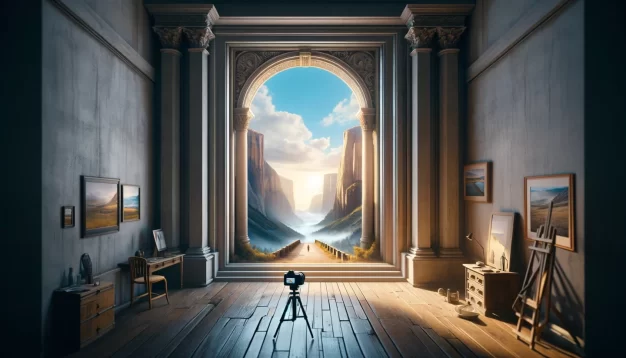Using the “Frame in the Frame” in your compositions
Master the art of visual storytelling through our expert guide on frame within frame techniques.

Introduction to Frame Within Frame
Capturing depth and context in photography can transform a flat image into a storytelling marvel. Diving into the archives of visual arts, the frame within frame technique is no new contender. It dates back to the Renaissance, where artists used this approach to create depth and nuance in their work.
Capturing Depth and Context
Photographers wield the frame within frame method as a powerful tool to convey a sense of place and layering within their compositions. It provides a window into the world of the subject, offering a deeper narrative.
A Historical Perspective
The inception of this technique can be traced to paintings and early photography where artists were compelled to introduce a sense of three-dimensionality and narrative within the two-dimensional constraints of their medium.
Understanding Frame Within Frame Technique
Definition and Key Concepts
Frame within frame is the use of elements within the scene to create a ‘frame’ around the central subject. It’s a compositional tactic that draws the viewer’s eye directly to the focal point.
Importance in Photography
The technique adds depth, context, and interest, encouraging the viewer to explore the image. It’s integral in guiding the viewer’s attention and constructing a visual hierarchy in the photograph.
Tools and Equipment for Effective Framing
Camera Selection
The choice of camera is less critical than understanding its use. Whether a DSLR, mirrorless, or medium format, mastery over its functions is paramount.
Lens Choices
Prime lenses with wide apertures are ideal for their sharpness and bokeh, enhancing the frame within frame effect. Zoom lenses offer flexibility in composing the shot.
Additional Accessories
Tripods can aid in framing precision. Lens hoods prevent unwanted light, maintaining contrast and saturation that are vital in delineating frames.
Composing a Frame Within Frame Shot
Identifying Natural Frames
Look for doorways, windows, or branches that encircle the subject. These elements act as natural borders within your composition.
Positioning Your Primary Subject
The subject should be positioned in such a way that the natural frame does not overpower it but rather complements its prominence.
Adjusting Perspective for Impact
Changing your vantage point can dramatically affect the relationship between the frame and the subject. High, low, and side angles can offer fresh perspectives.
Technical Considerations
Aperture and Depth of Field
A wider aperture can blur the framing element slightly, placing the emphasis firmly on the subject while still leveraging the frame.
Focus and Sharpness
Critical sharpness on the primary subject is a must, with the framing elements in soft focus, ensuring they do not distract.
Lighting and Shadows
Use lighting to your advantage; it should enhance the depth and not flatten the framed effect. Shadows can also play a crucial role in defining frames.
Creative Approaches to Frame Within Frame
Experimenting with Different Frames
Frames come in all shapes and sizes. Experimentation can lead to unique and intriguing results.
Incorporating Color and Texture
Contrasting colors and textures between the frame and the subject can amplify the effect and guide the eye.
Storytelling Through Layers
A frame within a frame can tell a story by itself, hinting at a larger narrative or context beyond the immediate subject.
Post-Processing and Final Touches
Cropping for Emphasis
Sometimes, refining the frame in post-processing can enhance the composition, eliminating distractions.
Contrast and Color Adjustments
Post-production is the phase to accentuate the mood by tweaking contrast and colors. The frame should lead to the subject, not away from it.
Sharing and Presentation Tips
Choose the medium that complements your work. Sometimes, a physical print within an actual frame can be a meta and striking choice for display.
Employ the frame within frame technique judiciously. It should add to the story, not just be a gimmick. Remember, breaking the rules after mastering them can lead to the most compelling images. Keep your eyes peeled for those serendipitous frames that nature and architecture freely offer, and when in doubt, simplicity is often the most elegant solution.